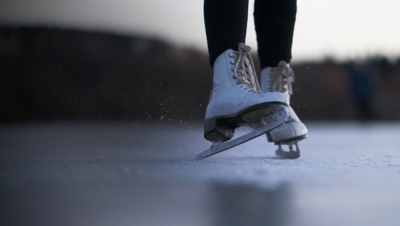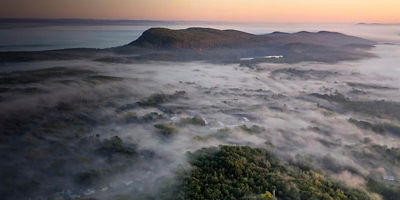
Every winter, outdoor skating rinks materialize all across Boston. While you’ll find polished pop-up rinks everywhere from Lynnfield to Jamaica Plain, locals know that the best scenery surrounds natural ponds that are there all year long.
Sometimes called wild skating or Nordic skating, pond skating is a staple local pastime and an incredible way to experience the outdoors in a new way. (It also makes a great family outing or outdoor date.) Here’s everything you need to know to get started.
When To Go
While city- and neighborhood-managed ponds are often monitored for ice thickness, truly wild ponds are not. If you’re skating in town, make sure the rink is officially open and/or cleared for skaters. This is usually November through February or March, as long as temperatures have been consistently below freezing for several weeks.
The season is about the same for backcountry ice, but be sure to confer with an experienced local first to get a feel for the conditions before heading out (see “Safety Tips” below).
Where To Go
From manicured city ponds to woodland pools and coves, here are eight of the best places to go pond skating near Boston.
Auburndale Cove
Located in far-west Boston, this 30-acre offshoot of the Charles River is managed for skating by the City of Newton each winter. Be sure to check the Auburndale Cove website for conditions and safety updates. Public skating is usually open from dawn to dusk whenever the ice is open.
Boston Common Frog Pond
Open November through March, the Boston Common Frog Pond is probably the most accessible pond on the list and the easiest place to learn how to skate. The pond hosts daily open skating hours as well as periodic shows and other events, including the annual First Night Skating Show on New Year’s Eve. You can also sign up for lessons and school skating programs here through the Skating Club of Boston.
Channing Pond
Located southwest of Boston, the small but charming Channing Pond is maintained and managed by the town of Dover. It’s well-lit in the evenings, which makes it a nice spot for a sunset skate. (Be sure to check the city’s webpage for safety updates before you go.)
Chebacco Lake
One of the bigger skating ponds in the area, Chebacco Lake sprawls between neighborhoods and quiet streets in Hamilton and Essex. Ice skating, ice fishing, and cross-country skiing are all permitted as long as the ice is thick enough.
Jacobs Pond
The 60-acre pool at Jacob’s Pond Conservation Area turns into a perfect outdoor rink as soon as the deep freeze sets in. Cross-country skiing, ice skating, and ice fishing are all permitted. When your skating muscles grow weary, consider exploring the rest of the park on foot: A number of trails wind through the pine and oak forest and offer deep solitude in the winter months.
Redd’s Pond
Situated in a historic section of Marblehead just beneath Old Burial Hill, Redd’s Pond is a popular local spot for both ice hockey and family skating. Warm up with a coffee at nearby Mookie’s when you’re done.
Turner Pond
Looking to escape the city? Head to Walpole, southwest of Boston proper, for a few laps on Turner Pond. Citizen-maintained and -managed, Turner Pond covers several acres of skateable terrain (a full lap is just short of a mile). There’s also a warming lodge located right on the shore. Conditions and opening hours are posted regularly on the Walpole Ponds Facebook Page; check for updates before you go.
Winter Pond
Nestled in a tree-ringed, glacially carved basin just north of Winchester, Winter Pond is a prime rock-skipping and birding spot in the summer and a popular skating site come winter. Take a few laps beneath snow-draped branches, or come with a hockey stick; Winter Pond is a popular spot for pickup games.


































